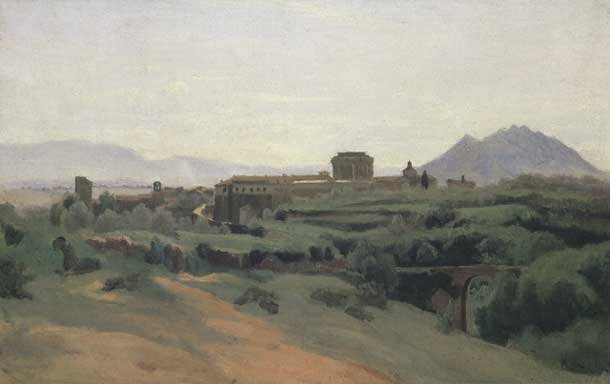
Corot’s view of Civita from Terrano
I’m finally able to post about my experience this past summer at the Jerusalem Studio School Summer Art Program in Civita Castellana, Italy. As many readers may know I’ve been helping the JSS with their blog and in promoting their summer program. I also asked a few other painters to contribute their impressions of Civita and the JSS program.
We waited to post this article until the full information and registration for the 2013 summer session in Civita Castellana would be available on the JSS Italy website. Next summer should prove to be an even better experience with the addition of a large studio facility the Terrano Studio Center and with the incredible painter Susan Jane Walp as the guest of honor.
The unforgettable views, history and art surrounding Civita Castellana was more than reason enough to go but my main feeling in joining the JSS Civita experience was that it would push my work further. I knew that the program’s intensity would fire up my imagination and get fresh insights into my work. This happened before when I attended the JSS program in Siena a couple of years prior which I wrote about and it played a major role in shaping new directions and understanding.
Despite the fact I’ve been painting for around 30 years I’ve never been convinced that I was finished being a student. However, until recently, I believed that study from books, nature, museums, online resources and daily practice was education enough. I’ve never been big on taking workshops and classes, perhaps due to my being either too cocky, opinionated or poor to sign up for someone else’s idea of how to best make a painting. Thankfully, as I get older I perhaps get a little more humility and become more open to hearing new ideas and criticism about my work.
With this thought in mind I decided to return for study with Israel Hershberg and Yael Scalia along with EM Sangia. I viewed taking this master class not unlike how I’d imagine a somewhat accomplished violinist, singer or guitarist might wish to take a master class with Pablo Casals, Maria Callas or Keith Richards. I secretly thought that studying with Israel Hershberg was the closest a painter today could come to studying with Corot.
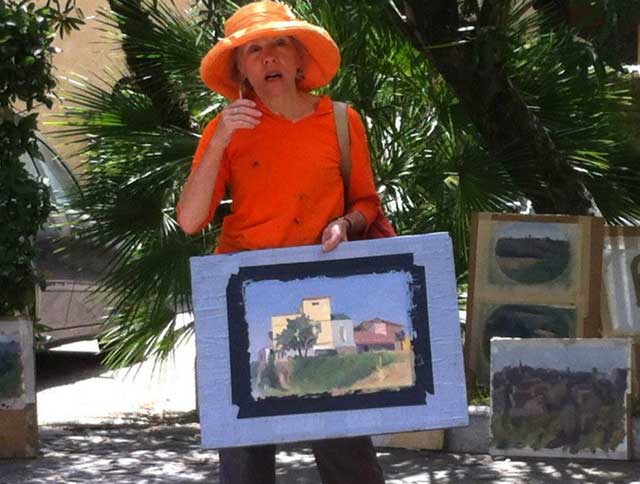
Yael Scalia critiquing my painting (photo credit: Yehuda Armoni)
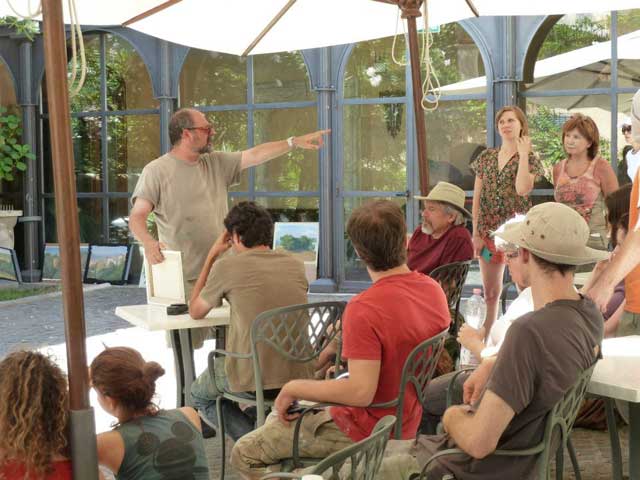
Pointed critique from Israel Hershberg (photo credit: Alison Kurke)
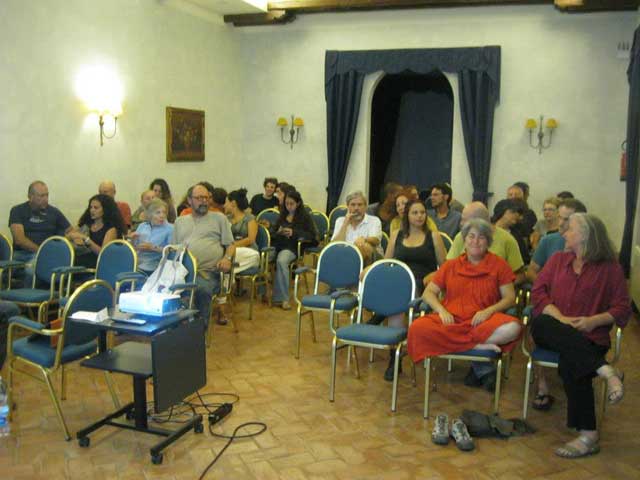
Slide talk about to begin in the Hotel conference room. (photo credit: Ron Prigat)
Loosening my ego’s grip and coming to the master class with a beginner’s mind was the key to getting full benefit of the teaching. My beliefs on the right way to paint, no matter how basic, needed to be put on hold so I could be open to new ideas. I was continually impressed with how insightful and relevant the critiques were to my work. Many critiques often used a finely honed honesty that went directly to the work’s jugular. Of course the critiques could be tough at times – showing unfinished work to one of the world’s greatest living landscape painters is not without a few anxious moments.
Each week we would have one or two slide talks from the faculty or visiting artists in the hotel’s conference room. Israel Hershberg’s slide talk on Corot was exceptionally good on the discussion of Corot’s thinking on composition and approach with his Italian landscapes. This one talk was more useful than many entire art history courses I’ve taken in the past.
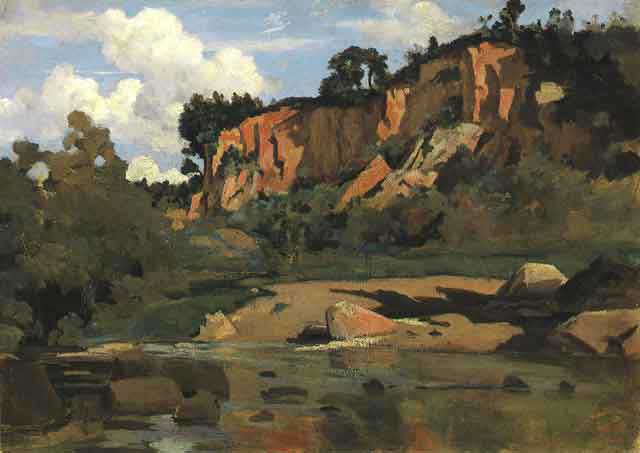
Corot
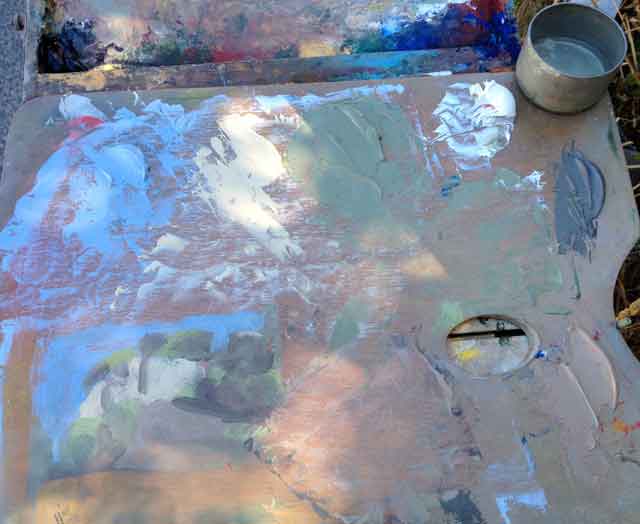
Palette thumbnail
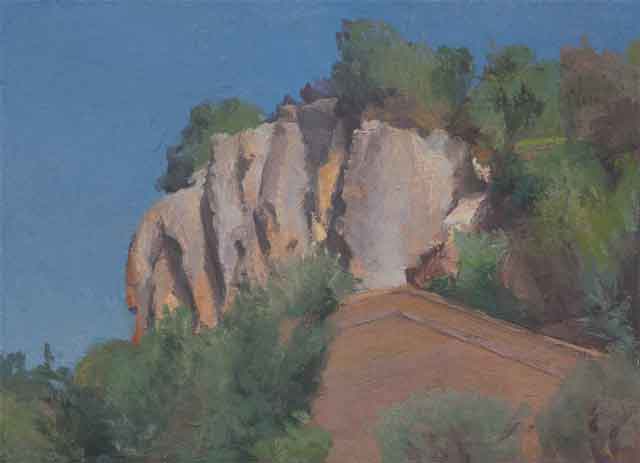
Finished painting
One assigned exercise was to make many small thumbnail paintings of Corot’s Italian landscapes from looking at images on a smartphone or ipad. The objective was to figure out how to simplify using a full color palette, working very broadly and quickly with big brushes with as few strokes as possible into in a 3 by 5 inch space and aim to have the painting still be recognizable. This exercise was invaluable in generating fresh ideas on composition, color and simplification of complex forms. Another helpful idea was to make an oil thumbnail sketch of the scene directly on the palette using just 4 or 5 colors generously mixed to represent the biggest shapes, then use those colors as the base colors for the painting (see photos above).
One of the biggest difficulties was in deciding what to paint – overwhelming possibilities everywhere you looked. At first I shied away from painting in the more public areas – but I soon felt more comfortable painting on the street – even painting right next to a busy autobody shop. People tended to be very respectful and welcoming. Not speaking Italian made it easy to not be distracted from people asking questions – “Mi dispiace, non parlo italiano” was my most used Rick Steve’s phrase-book entry… The other difficulty was in synching a great view with good shade but once becoming fully engaged with the painting you can often ignore the heat and other discomforts.
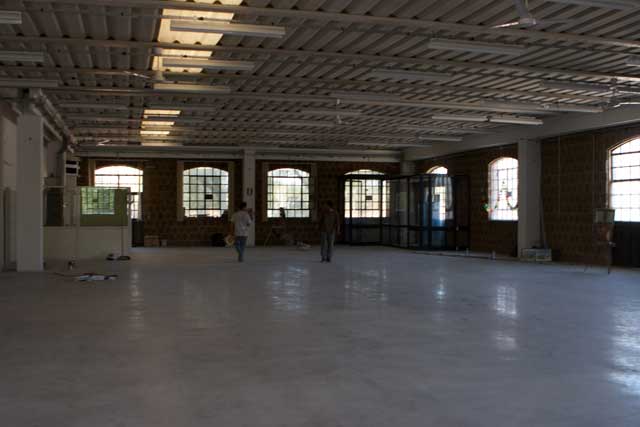
The awesome new Terrano Studio Center which will be partitioned off and ready for use next summer – first come first serve!
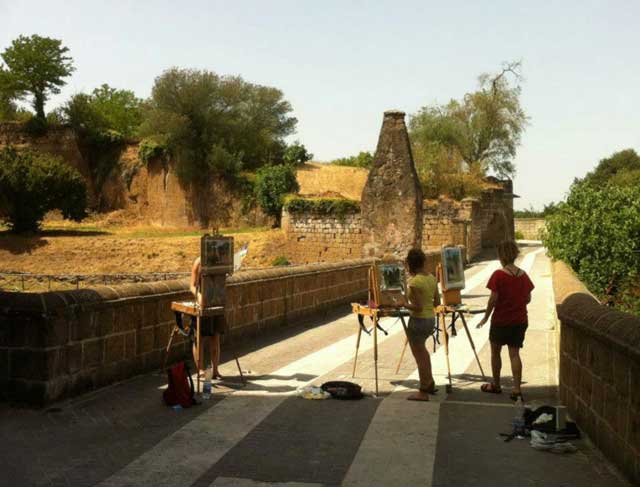
(photo credit: Yehuda Armoni)
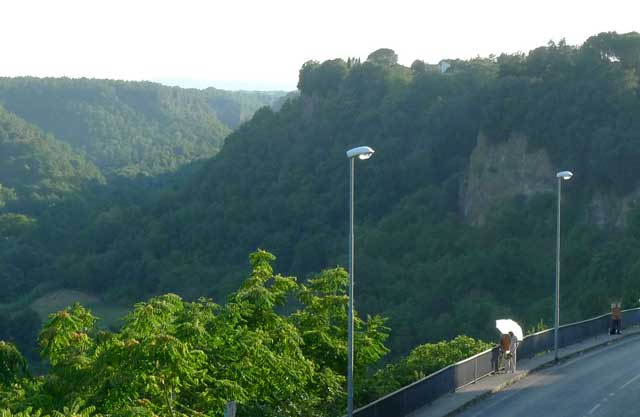
In addition to getting feedback from respected painters I wanted to paint with no outside obligations and distractions. I lucked out and by an unplanned twist of fate I managed to get an apartment all to myself. My windows looked out onto a variety of rapturous views including Monte Soratte. I’m not sure how old the house was but I liked to think that Corot himself might have visited there.
People staying at the hotel had much better creature comforts like air-conditioning, showers, comfortable beds and WiFi but my place did cool off nicely at night and I slept well. My apartment lacked a shower and getting used to taking baths after 50 years was a little weird but I quickly forgot these minor discomforts in the ecstasy from the views from my balcony and roof-top from which I made several paintings.
I woke up early to run down to the nearby bakery to get some fresh bread and croissants that were to die for. There were many options for eating at various restaurants, some incredible meals there – worthy of an article all to itself. However, To save money I often cooked my own meals – for lunch my favorite was the fresh Mozzarella di Bufala with tomatoes and fresh basil. There was a wonderful little farmer’s market to buy fresh produce from surrounding local farms as well as an interesting shop for fresh pasta and a few small grocery stores.

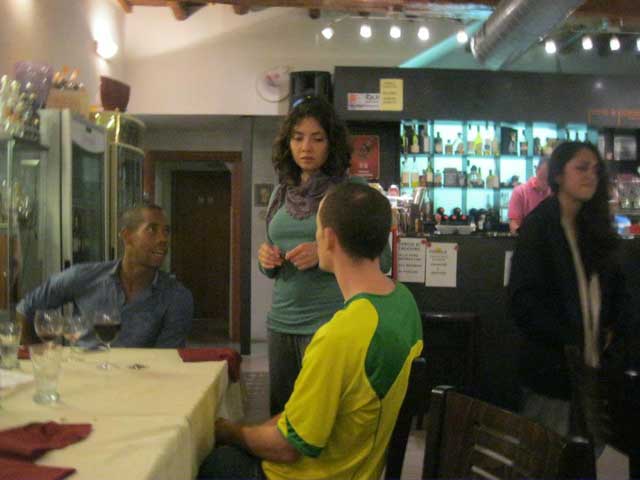
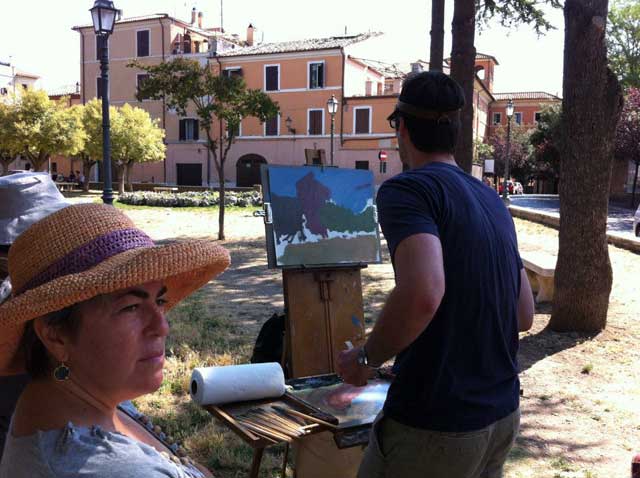
Painting was best started in early morning when there were cooler temperatures and the light was best, mid-day was often too hot to be painting and that’s when we met for the daily critique. Most of the town’s stores closed mid-day and everyone took it easy. Around 4pm life started back up and people resumed their paintings until dark. The group suppers were served at a few excellent restaurants – often with several courses starting around 8pm and last well into the evening with lively conversation. In the center of town there were a couple of bar/coffeshops in which you could hang out in the evening by an ancient fountain with other students along with the townspeople over wine, coffee and gelato while making use of the free WiFi.
There was a terrific little gelato place I would go many nights to get a cone and then walk around the town. I felt totally safe and even though I hardly spoke a word of Italian I loved hearing the warm tones of the language being spoken from the families’ patios and porches.
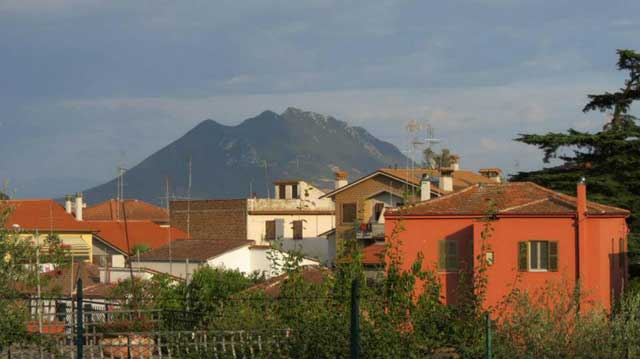
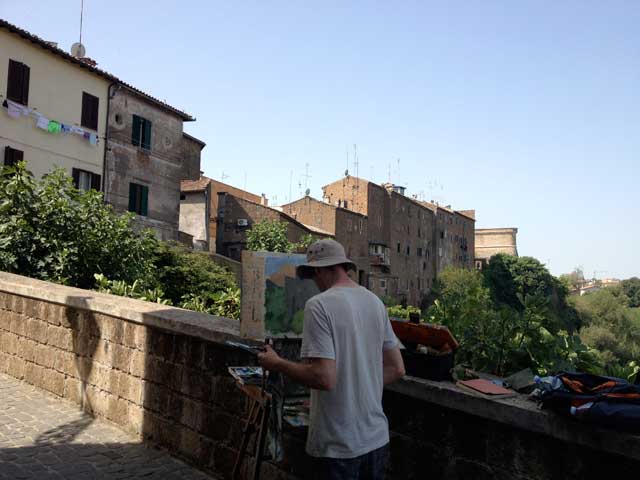
Of course the main reason painters go to Italy is for the overwhelming number of masterpieces and great museums, enough for a lifetime of study. Our program had weekly trips to various locations in Florence, Naples, Bologna and the Piero della Francesca tour which included Urbino, Arrezo and Sansepolcro.
BBC documentary – The Private Life of a Masterpiece – Piero Della Francesca Part 1 of 4.
One unique aspect of our trips was the intensity of the study of the works being seen. For instance, in Florence we spent close to two hours drawing from the Masaccio frescos in the Brancacci Chapel in Florence, slowly savoring every moment – however afterwards at the Uffizi Gallery I totally gorged myself with a frenzied painting overdose.
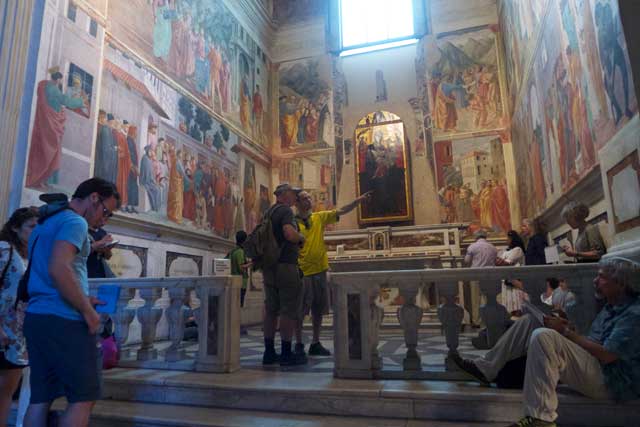
Drawing the Masaccio frescos in the Brancacci Chapel (image credit, Israel Hershberg)

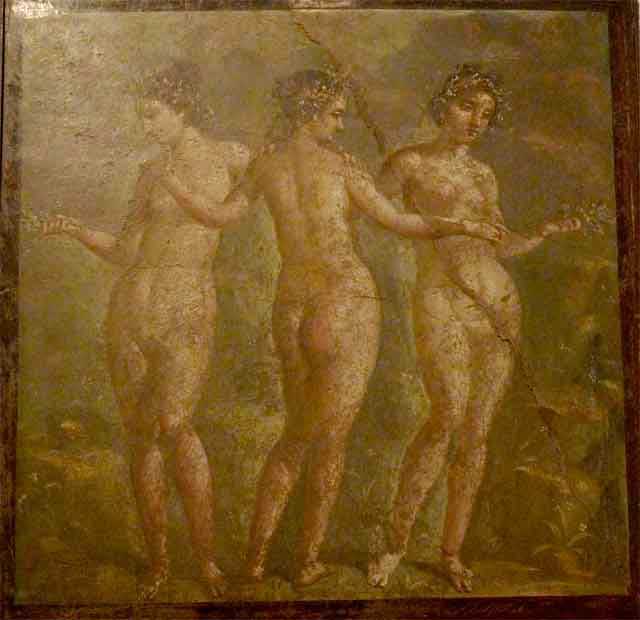
Drawing from ancient Roman fresco’s from Pompeii in the Naples Archeological Museum was one of the high points of the trip – despite the insane heat of this non-air conditioned museum (charmingly referred to as basking in the uterine waters of painting!) We spent an entire afternoon drawing and examining these 2000+ yr old mosaics, frescos, and sculpture.
Video about the Naples Archeological Museum
I had visited the Morandi Museum in Bologna before but this time I looked even more closely and spent much time drawing from the paintings. Studying the compositions closely from life has perhaps been the one of my most influential art experiences. No serious painter should go through life without a pilgrimage to Bologna.
The other great draw to Civita itself is that it is so close to Rome – only around an hour’s train ride to the Piazza del Popolo where you can see two Caravaggios in the Santa Maria del Popolo. The train station for Civita is at the ancient northern entrance to Rome where countless treasures are soon found either on foot or metro. It is a very easy day trip to go off on your own, perfect for the Fridays and Saturdays which were the programs “free” days.
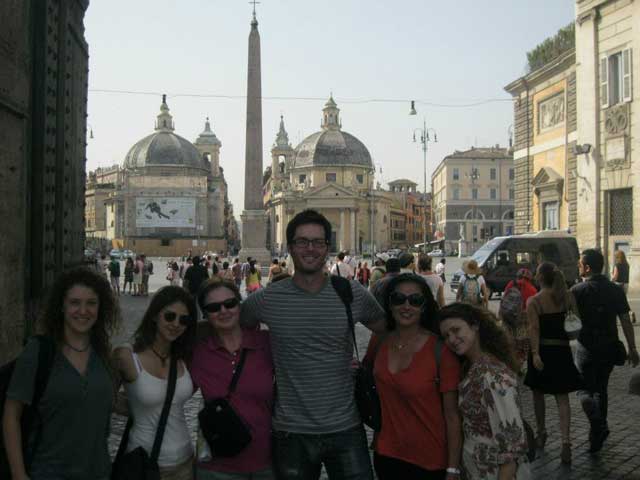
Day trip at the Piazza del Popolo
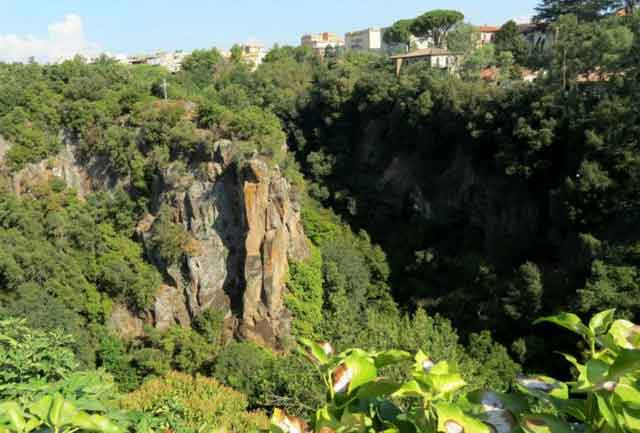
(photo credit: Ron Prigat)
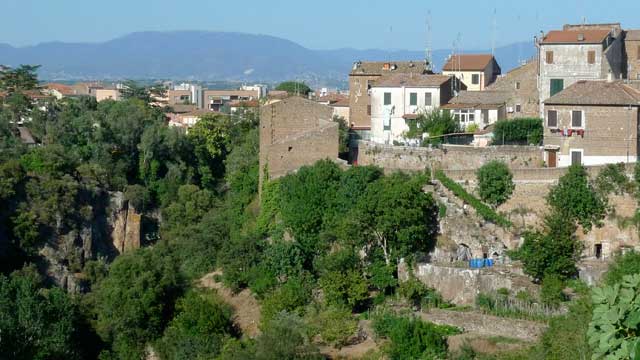
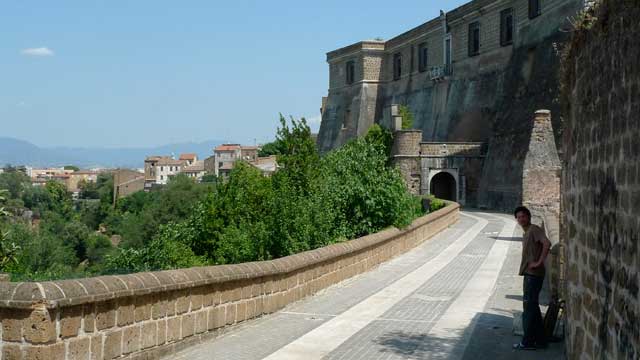
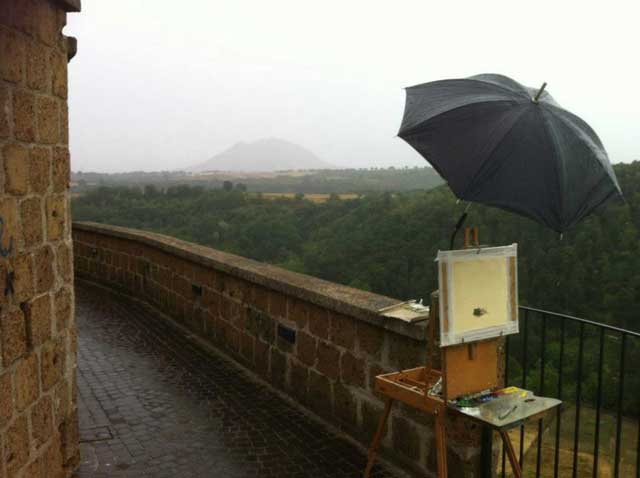
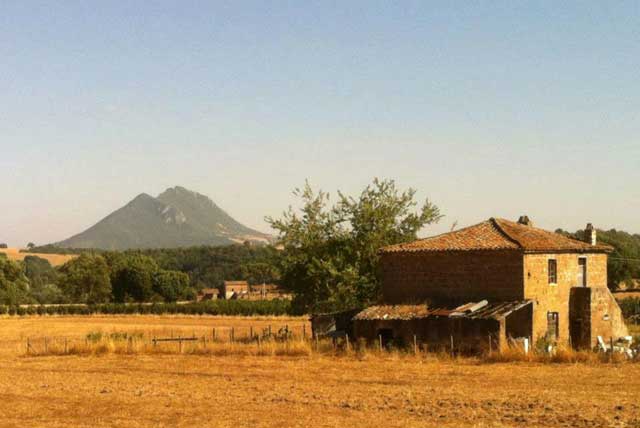
(photo credit: Yehuda Armoni)
There were many fabulous painters in Civita this past summer both teachers and students. I was lucky to start to get to know a few of the people there, the people who impressed me the most were the Israeli JSS students; the intensity of their seriousness, dedication and talent was awe-inspiring. I’m only showing here a couple of select works from the JSS student work this summer but you can see a comprehensive survey of many of the JSS students from this link
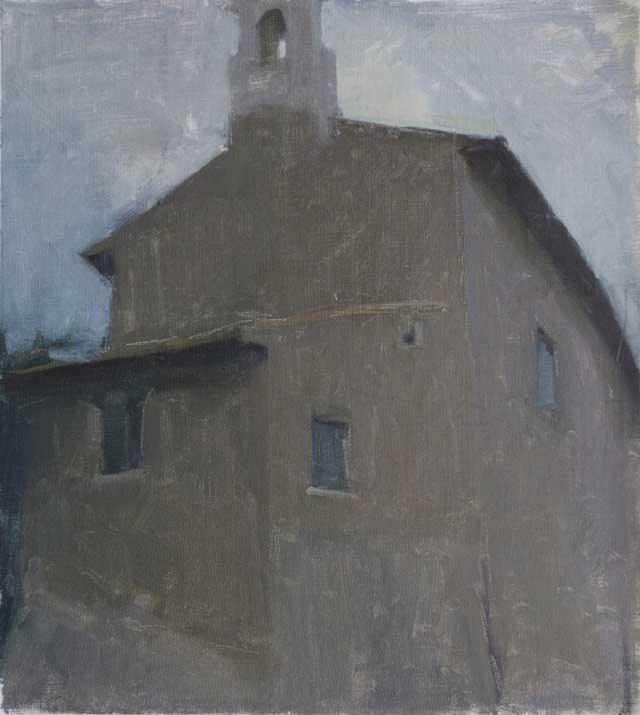
Lena Tzur
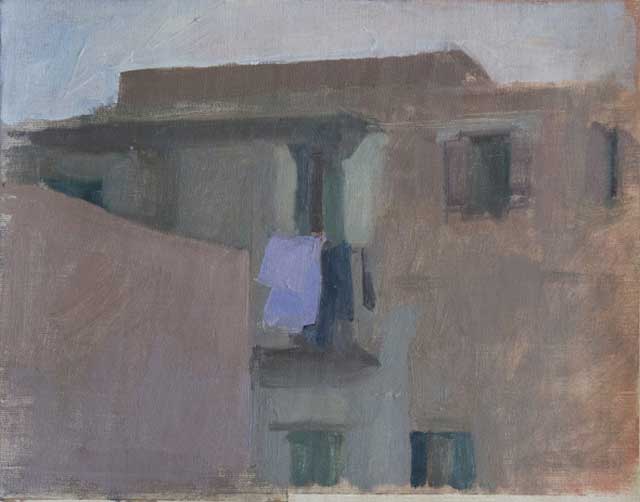
Lena Tzur

Oleg Lissin
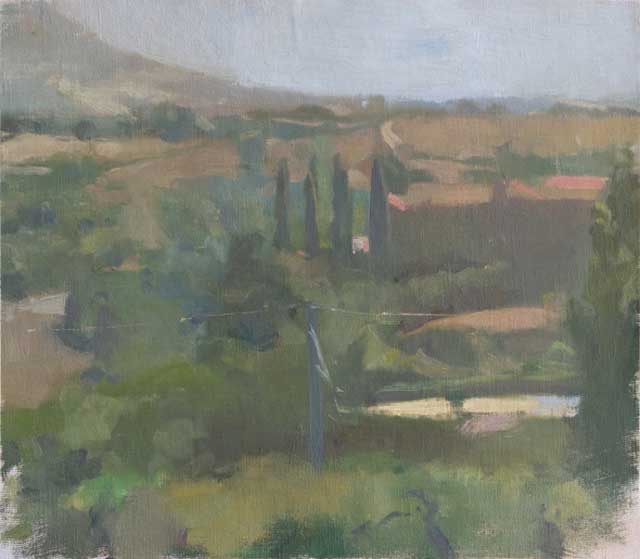
Oleg Lissin
I was fortunate to meet Alison Kurke, an American living in Civita Castellana full-time. She has been very active in promoting Civita as a great place for artists to visit. I asked her to say a few words about Civita for this blog.
What I have always liked about Civita is that it is gutsy and down to earth. And that it’s NOT Tuscany. It’s an ordinary sort of town that is sort of extraordinary in its ordinariness. It is and has always been much less affluent than Tuscany because it was under the thumb of the Church much more directly than Tuscany or Umbria. (It is also convenient for Rome’s airports). The other thing I love are the paths along the rivers and up to the ancient and medieval settlements every few kilometers. Descending into the ravines here is like stepping back 3000 years. So few of the local people appreciate the natural beauty of the area, but the ones who do are amazing passionate about their appreciation of it. All of this means that it is an affordable place in Italy to stay, to paint, to live, a town unaccustomed to tourism and to being appreciated for its beauty, with many inhabitants who are welcoming of visitors. Artists visiting here or staying for a few weeks can feel themselves part of a long tradition of artistry. And make a few local friends among the residents.
The residents mainly see Civita as a town that is suffering from having put all of its eggs in one basket – the factories. Now that the industry is in trouble, they feel the downward trend more acutely. They see the usual things (litter, graffiti, too few parking lots, foreigners in the centro storico) and think the worst, but are afraid to move forward with real change here. And yet, a couple of years ago, a local historian published a big fat dictionary of the local dialect. Small steps are being taken to make improvements in the old center of town. Having people around, especially young people, painting the beautiful aspects of the town really pleased and heartened them. Who could fail to be blown away by the view of the Castellaccio and the ravines from the Ponte Clementino!
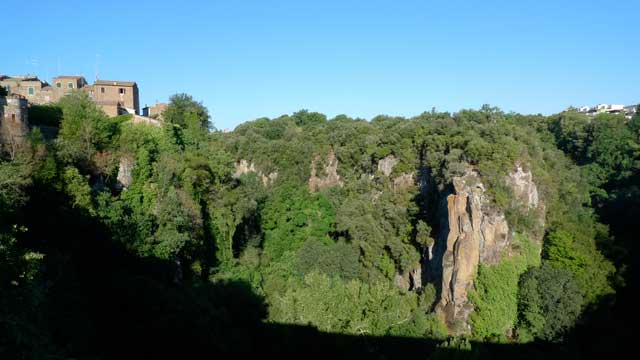
(photo credit: Ron Prigat)
EM Saniga was the guest of honor and teacher. I asked him if he might share something about his experience in Civita.
“What sticks in my memory of Civita Castellana is the clarity of the light and the opportunity to stand in the footprints of painters like Corot and paint a landscape in some cases very much unchanged from the time these masters stood here. Add talented and well trained painters and students to hang out with in the restaurants each night over fine food and wine and you find it is a hard place to leave.”
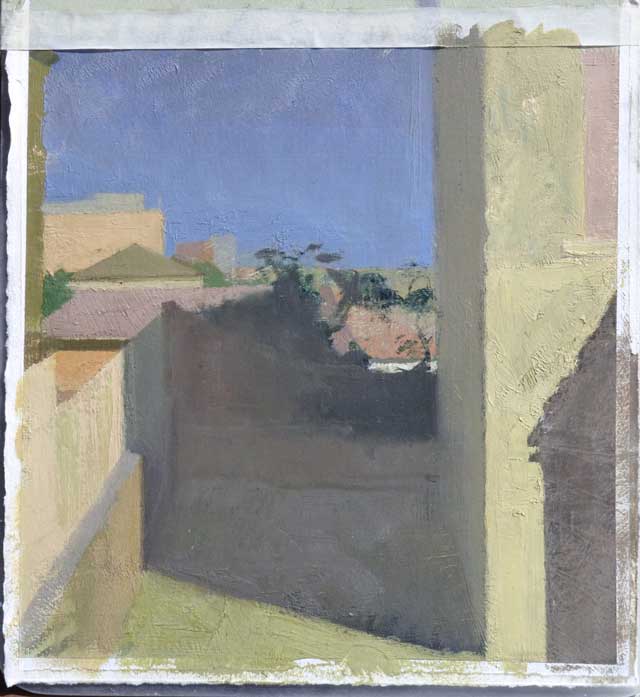
Emil Robinson – Civita
Emil Robinson is a wonderful painter that I’ve interviewed previously for this blog. Here is a link to the interview. He lead one of the affiliate workshops.
He had this to say about Civita…
Civita Castellana is a town made for painters. Inexpensive, quiet, and pregnant with mystery. The old town sits on an ironing board shaped plateau of land. Upon reaching the edge of the village at any spot, the artist is confronted with vistas. These views over look gorges, out across valleys onto distant planes, and reveal the omnipresent specter of Monte Soratte. On top of that, the artist is aware of the great precedent set by other artists, most notably Corot.
The intensity of the other artists, and the vitality of the setting turn this immersion into a baptism.
Brian Rego was another amazing painter who lead an affliate workshop. I also had interviewed him for this blog which you can read from this link.
“I was first struck by the fullness of the landscape in Civita. There is a unique quality to the light that seems to enhance the level of descriptiveness to each and every surface, from wall to ground to foliage. Everything becomes monumental, even the tiniest passage. Somehow, painting takes on a renewed purpose in this place. I would make this trip again a thousand times over.”
Judith Green A fabulous British painter who Neil Plotkin interviewed for Painting Perceptions awhile back also attended the Civita program. She wrote a longer essay about her experience in Civita which you can read in a pdf here) in which the following is excerpted from:
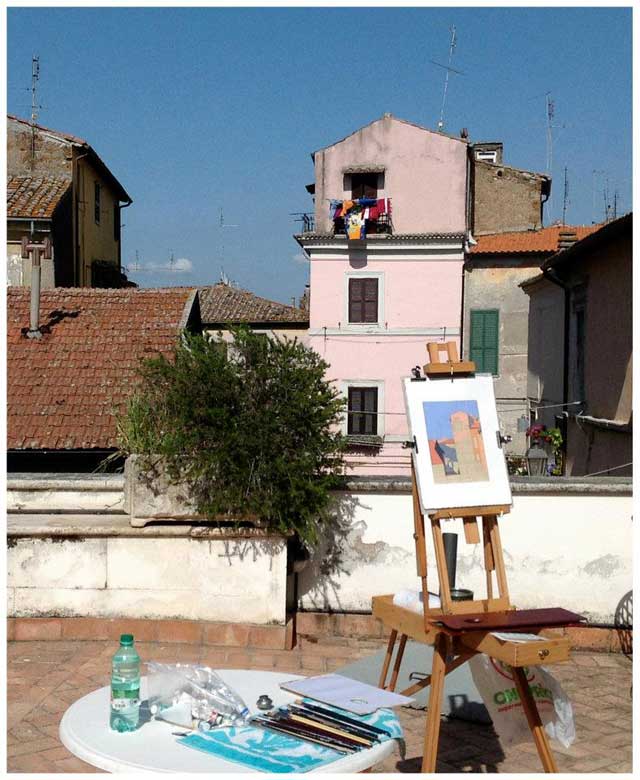
Judith Green
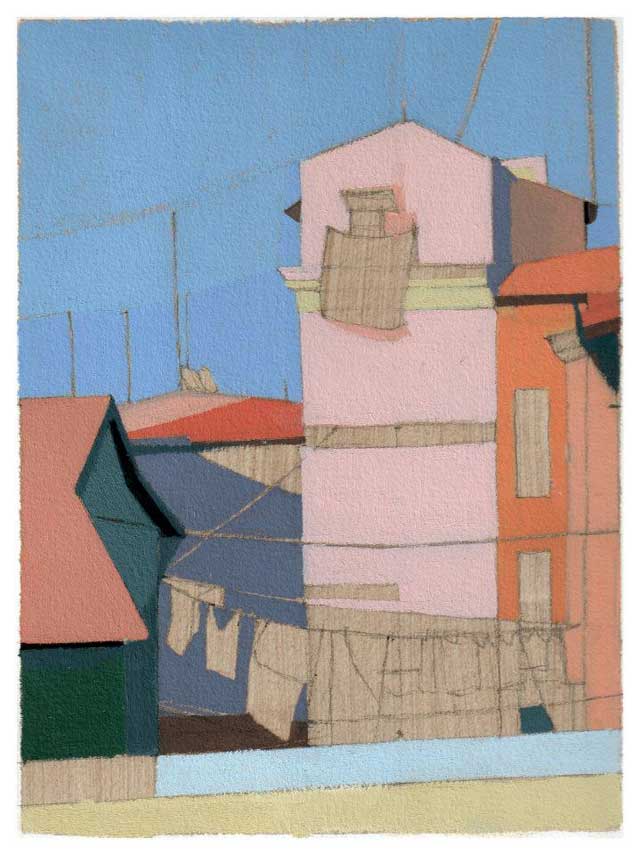
Judith Green
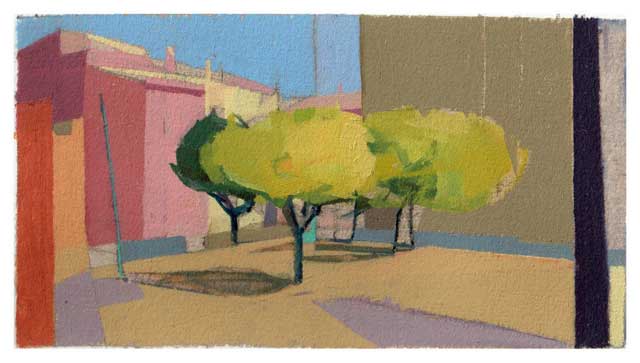
Judith Green
Civita Castellana was architecturally fascinating with many extraordinary details and a distinguished history. We were spoilt with unusual and breathtaking motifs from the main fortress and surrounding perimeter wall, to Mount Soratte one way and the deep gorges of Tufa dotted with catacombs the other. A town un-spoilt and real, washing lines hanging above your head, families accompanied by grandparents, children and pets all around. It did feel like a movie set. The whole group was embraced by the locals who were very proud to have all these artists in their midst. At night it was lively, friendly and safe. I chose to eat supper with the small group of painters staying at the hotel, all our meals were pre-booked in local wine bars and restaurants, rotated every week. Meals were fresh, authentic with a vegetarian option. Wine was included but a modest amount. I really enjoyed getting together at the end of the day, sharing ideas and interests it was a very supportive and collaborate atmosphere.
At last the full day coach excursion to Urbino, Arezzo and Sansepolcro this was a dream come true. The journey was long, hot and exhausting but to be able to see the paintings and fresco’s of Piero della Francesca and Giotto was invigorating. The excursion was exciting with the most picturesque natural beauty all around. The atmosphere on the bus was terrific everyone mixing together, teachers, painters and students with mutual respect and admiration, having spent quality time over the past two weeks, sharing personal group discussions and critiques. Israel telling jokes most of the way, reading extracts and reciting poetry.
Coming to Civita Castellana and seeing first hand how the young Corot’s paintings clearly demonstrated his gained possession of the Italian landscape, rhythmic and dynamic, realizing his modern approach to landscape and how it has exerted such a powerful influence on the generation that followed, especially Cezanne is what I take back with me.
I have met some incredibly talented, highly focused accomplished artists. Gained new friends and have been inspired. Returning to my studio in Cornwall full of motivation, empowered and reflecting on my experience.
Eileen Eder is a very accomplished painter who teaches her own workshops in the New York area. She also had many insightful things to say about Civita and the program. You can read her essay in full from this link. Below are excerpts:
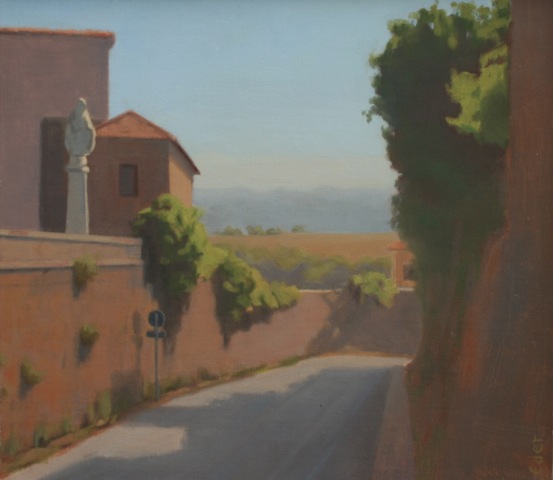
Eileen Eder – Mura della Città, oil, 16-1/2 x 13-3/4
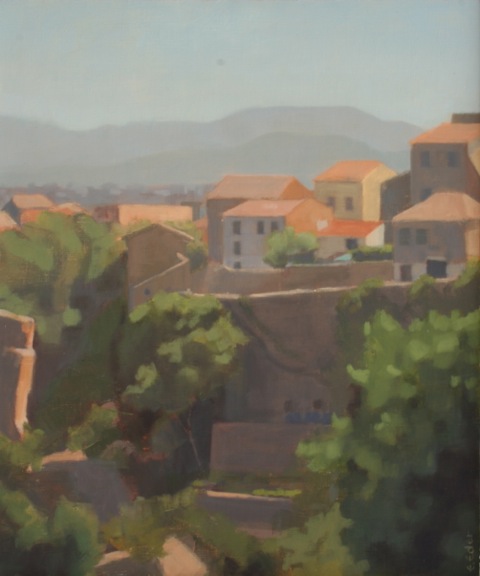
Eileen Eder – Mura della Città, oil, 16-1/2 x 13-3/4
I’ve admired Israel Hershberg’s work for some time and came across his Master Class in Italy when an artist friend was planning to take a class to join his group. Truly “an opportunity too good to miss” was my only thought and I applied for admission, cleared my calendar, convinced my family and made plans to join the group for one month of intensive landscape painting in Civita Castellana from mid July to mid August 2012. Even though I have been painting for years, show in galleries and teach painting classes myself I saw this as an opportunity to improve my work. Israel works in a realist, perceptual manner with outstanding aesthetics and I wanted to absorb some of his exquisite, artistic taste. I hoped my paintings would attain a fresh perspective and I would return home with a “new and improved” goals for future work.
Now that I’m back home and gave had time to reflect on the trip here are some of the highlights; the camaraderie and conversations between 30 to 40 artists all living and working nearby and often sharing meals together, the beautiful and ancient town of Civita Castellana and surrounding area offered amazing and beautiful motifs wherever you turned your head, the ability to paint morning and evening 6 days a week (Thursdays we traveled to see major influential artists in churches or museums, a major adjunct to our learning), the frequent inspiring lectures from distinguished artists and, finally and probably the most important, was learning by seeing everyone’s work and listening to the group critiques for the Master Class I was in that were conducted by the artists Yael Scalia and E.M. Sangia (our guest artist for 2 weeks) as well as Israel Hershberg.
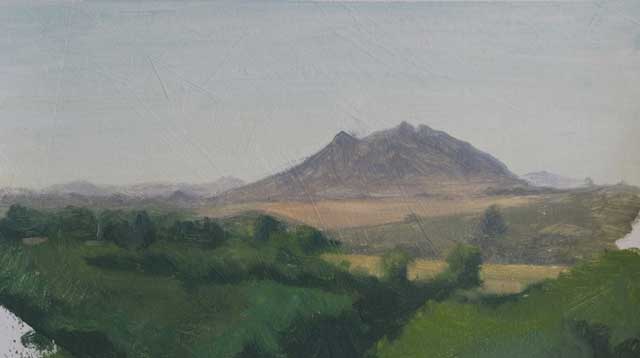
Yehuda Armoni
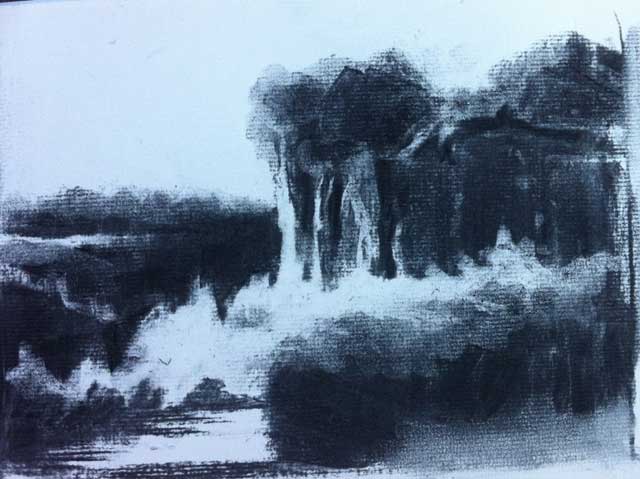
Yehuda Armoni
One student in particular that I became good friends with there was Yehuda Armoni. I asked him if he could write something about his experience in Civita
He responded with the following:
Two years ago, while accepting me to the Master Class, Israel Hershberg warned me that I am going to face more difficulties than others, due to my age. I am already a grandfather and am the oldest student in class. Israel told me that “I know too much” and that it will take time to clear my brain before I’ll be able to comprehend his method. He was right… I have difficulties, while the young ones do it naturally and much easier.
Civita Castellana is the second place in Italy where I participate in the JSS Italy summer program. The previous one was Certosa di Pontignano in Tuscany near Siena. I feel that the Italy program is the optimal way for me to make big steps aiming the target of being a real painter. The program is composed of “hard labor” of day by day painting in wonderful landscapes, except for a day a week in which we travel in churches and museums where we may watch closely the Old Masters works. In Israel we have nothing like that…
This year, in Civita, it was overwhelming. Being in a place where many Old Masters painted was an unprecedented experience. Especially when I saw the motifs painted by Corot, one of our role models of painters. Seeing “his” famous Monte Serrate was an experience very closed to the experience I felt seeing the Pyramids in Cairo in real for the first time. The area of Civita is beautiful, full of motifs, but being in places where Corot stood and painted was enchanting!
One of the main tools we have in the program is the daily critique with our teachers. This year there were; Israel Hershberg, Yael Scalia and E.M Sanega. Each one with his unique point of view enriched us enormously. Sometime they were not easy, even tough, however the feedback you receive to your own works and to works of others has extreme value and affects immediately your next painting.
I know I am going to face another year of hard work in the JSS, however, I already start to imagine my next summer in Italy…
Finally I’d like to take the opportunity to show a few of my own paintings from Civita.
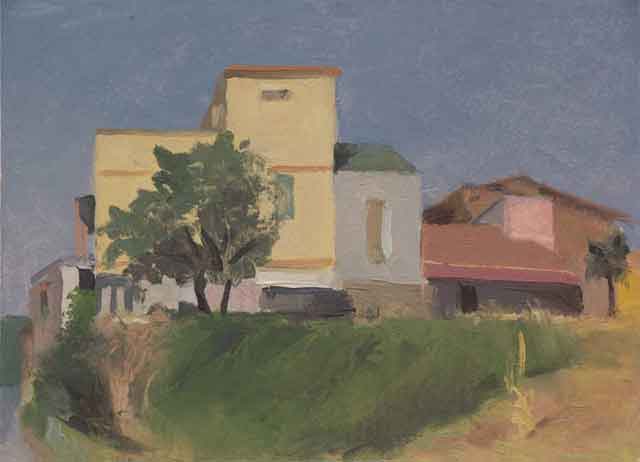
Larry Groff
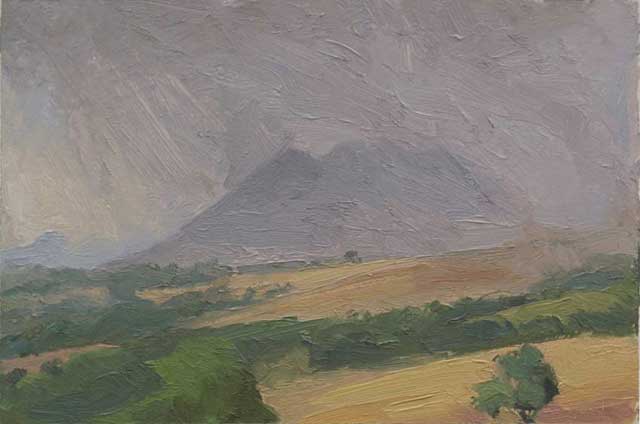
Larry Groff
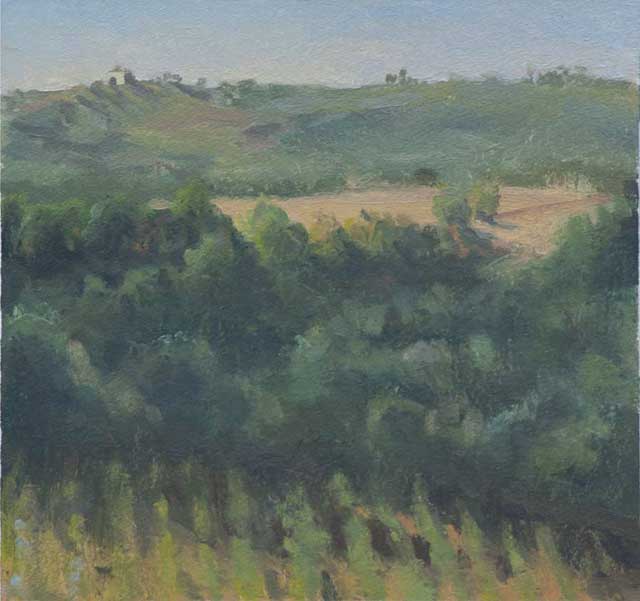
Larry Groff
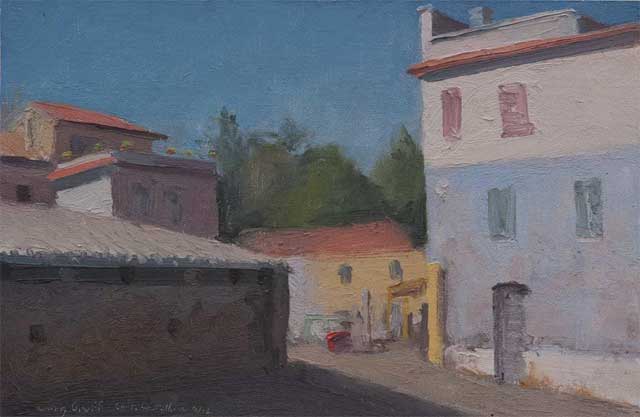
Larry Groff

Larry Groff
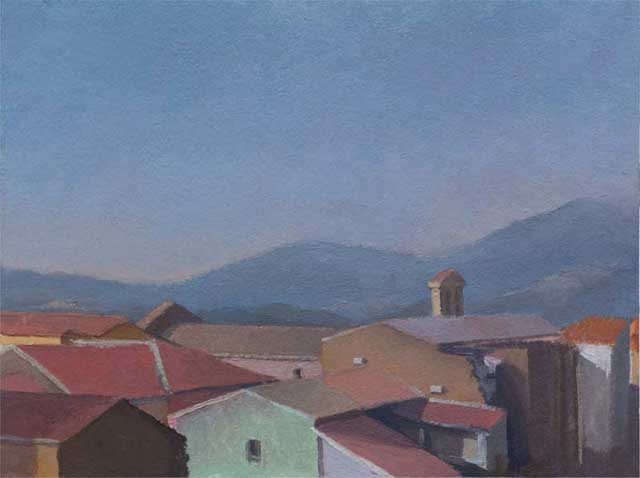
Larry Groff
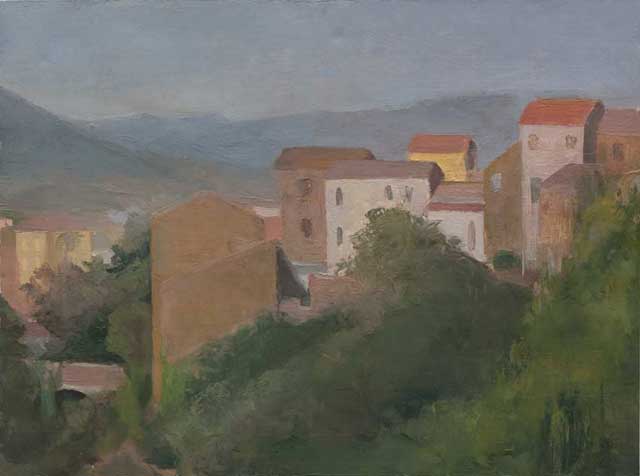
Larry Groff
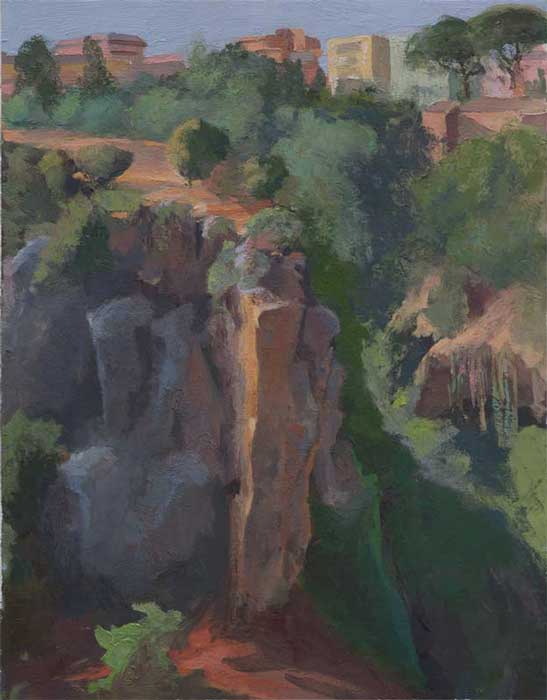
Larry Groff
Please visit the Jerusalem Studio School Summer Art Program new website for comprehensive information, terrific photos and registration.

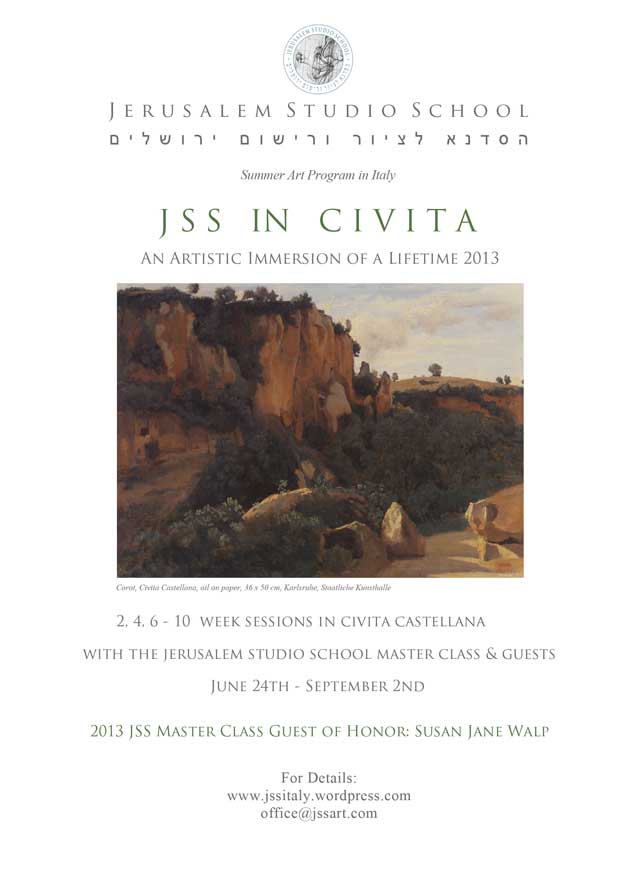




very nice blog about civita. I went there on day trip a few times several years ago to sketch.
I am great admirer of corot and valenciennes.
I would very much like to rent an apartment there for a month in may. do you know any one could contact?
thanks
randolph
Thanks Phillip – that means a great deal coming from you.
Randolph – I can probably get you an email address from Alison Kurke (quoted in the article) I will send it to you by email. If you’re on facebook, she is there. She lives in Civita and knows at least one person with a great apartment – that may or may not be available.
Larry, you got some excellent paintings done while you were in Italy!
Thanks so much for introducing me to Civitas and the JSS. I wonder if there was a year round art community there (in Civitas)? Life drawing or painting?
I’m always thinking about a long term visit to Italy, and that seems like a wonderful place to paint and base oneself out of.
Thanks for the interesting blog. sorry I’m so techno-dim, but would you know why I can’t see any pics? Captions are there but no photos.
Kathleen, sorry to hear you’re having problems with seeing the images. All the images for this article are visible to me here on my browser. Could you try again – maybe with a different browser/time and please email me if you’re still having problems. (larry@173.254.55.177)
Hi Larry, I must say that the artists on this trip are extraordinary including you. Just riveting paintings and compositions of great beauty. I love the article of the trip with wonderful insights.
Larry,
What an interesting and insightful description of your time at Civita along with the writings and images of others who painted in the program. Susan sent me the announcement of her teaching there, so I went online to have a look. It looks wonderful! Your paintings are terrific. Love the directness of them, the luscious color and energy. Bravo!
Thank you for your kind words Barbara!
I am going to go for two weeks this summer as a resident . I have so many questions like… Will I have the same experience and intensity of study as a resident verses a student. I also wonder if the dialogue from meals is worth the difference in cost of food. I am thinking if staying at the hotel because I want to be close to the center of things but wonder if this is necessary. I think it is more than possible that next year I will take the master class since their faculty and visits artist are incredible. I would so appreciate any input from anyone to help me make decisions about this adventure. I am very excited. My children want me to get so reviews from people who have attended. This site is all I have found and am great f or for iary
Hi Mary, congratulations on going to Civita, I’m sure it will prove to be amazing experience no matter what type of study you choose. If you can at all afford it I would recommend you take the Master Class and go for as long as you can. Two weeks is better than nothing but I’ve heard many people say they wish they had been able to stay for longer. For many it takes a week or so to get comfortable with the new surrounding and people. I also recommend you stay at the hotel if you can afford it. That way you get to hang out with the other students more and are always around when things are going on. I stayed at my own place and it was great but having to cook, buy food and not having the easiest place to get to in the middle of the day was sometimes problematic. Plus it was easy to be isolated. However, there were many pluses with having my own place – namely – it was my own place! and it had a killer view from my porch-roof that I painted from regularly. I envy you going there this summer, regretfully I won’t be able to swing it this year – hoping for next year.
Love this website. I am thinking of going to Civita totally on my own and do some painting (plein air), and take a look at the school for future reference (possibly sign up for a couple weeks on the spot if they would contemplate such a thing) . My impression is that this town would be a nice place for independent painting — any comments. (I’ve had some poor experiences with workshops so I am a bit gun shy now !)
Jim, The town would love to have you and there are many empty apartments and bed and breakfast type places, but you will need to find them on your own. I don’t know if the Hotel will have any rooms free during that time. I’m pretty sure they are the only hotel in town. The town isn’t a big tourist center so likely a bit harder than other places to find a good room and transportation.
thank you Larry; I was pleased to find this. I’ve always loved Corot’s Civita Castellana paintings, and I’m happy to learn of the opportunities to paint there. It would mean a lot to me to be able to do so.
Thank you for a very informative article about Civita. The assignments you described are fabulous ideas and I plan to implement them immediately into my own practice. This June I will be in Rome painting and hope to get to Civita for at least a long weekend of landscape painting. My goal is to pack as little as possible and wondered which oil colors you found to be most valuable for the Italian landscape. Any other tips on must have materials would be most welcome. Oh! and do you know which train station in Rome I should go to to get to Civita?
Hi Gabby,
In Rome you can take a train from the Piazza del Popolo at the Flaminio station right outside the main gate – just go to the ticket counter for the ticket – As I recall they had a train leaving about every hour or so (maybe different on the weekend) This train (I think it is the Roma-Viterbo line) makes all the stops at each town so it takes maybe hour and half to get to Civita. Civita has two train stations – you’ll want the one right in town and not the one outside of town (sorry don’t remember the names)
They don’t really have taxis or anything so you’ll need to either walk or get a ride from someone to the hotel. You’ll probably want to book a reservation – not sure if the school will have many students there then. Or you could try Air B&B – they had a surprising number of place available when I looked awhile back. Or maybe someone from the JSS could help you out? Civita is great, you should have a wonderful experience. It helps to have transportation but there are many places to paint right in town or just outside. I’m going there at the end of June and will be there until August 12.
In terms of your palette. I find it is too individual in terms of how you go about painting, especially if you paint more tonally, you may want to use more earth colors – but I can’t imagine going anywhere to paint and expect to get good color without having a warm and cool version of the primary colors. I use Cad. red and Aliz Crim./Cad Yellow warm and cool/Cobalt Blue and Ultramarine Blue/ Sap Green and Viridian (or other cool green) sometimes use other greens as well – some are big on Phthalo’s there but I’m less fond/ I like to use Raw Sienna and sometimes Williamsburg’s Italian Raw Umber and their Pompei Red -any of their Italian earth colors are great.- I could get by with just that but I often use more. I will probably get paint in Rome this time rather than bringing a lot with me. I’m trying to figure out a way to travel much lighter this year.
I think there is a suggested palette list on the JSS in Civita site you may want to look into as well.
Hope you have a great time.